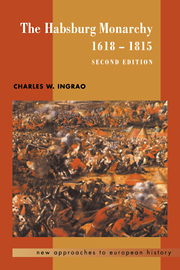Book contents
- Frontmatter
- Contents
- List of maps
- Genealogical tables
- Preface
- 1 The distinctiveness of Austrian history
- 2 The Thirty Years' War (1618–1648)
- 3 Facing east: Hungary and the Turks (1648–1699)
- 4 Facing west: the second Habsburg empire (1700–1740)
- 5 The Prussian challenge: war and government reform (1740–1763)
- 6 Discovering the people: the triumph of cameralism and enlightened absolutism (1765–1792)
- 7 The age of revolution (1789–1815)
- 8 Decline or disaggregation?
- Bibliography
- Index
- More titles in the NEW APPROACHES TO EUROPEAN HISTORY series
7 - The age of revolution (1789–1815)
- Frontmatter
- Contents
- List of maps
- Genealogical tables
- Preface
- 1 The distinctiveness of Austrian history
- 2 The Thirty Years' War (1618–1648)
- 3 Facing east: Hungary and the Turks (1648–1699)
- 4 Facing west: the second Habsburg empire (1700–1740)
- 5 The Prussian challenge: war and government reform (1740–1763)
- 6 Discovering the people: the triumph of cameralism and enlightened absolutism (1765–1792)
- 7 The age of revolution (1789–1815)
- 8 Decline or disaggregation?
- Bibliography
- Index
- More titles in the NEW APPROACHES TO EUROPEAN HISTORY series
Summary
It has long been customary to regard the French Revolution as a great event in western civilization, a defining moment in the development of world democracy that sounded the death-knell of monarchy. Today a great many scholars see it as at best a mixed blessing, both for France and for the continent as a whole. But it was worse than that. Far from heralding the end of monarchy, it gave new life to conservative forces by permitting them to blame the Enlightenment for the Revolution's unfortunate legacy of domestic terror and international aggression. The French Revolution was nothing short of a catastrophe for the monarchy, not because it was ideologically hostile to the Habsburg state, but because it unleashed hugely powerful, aggressive forces that prompted much of the monarchy's ruling elite to cast off Enlightenment values that now became linked to the French enemy in favor of the reassuring safety of an outmoded feudal order.
The twilight of the Old Regime, 1789–94
Of course, the domestic political turmoil of the past three years had closely coincided with the outbreak of the French Revolution. Yet events in France had virtually no impact on the government's handling of their own domestic crises. Neither Joseph II nor Leopold II viewed the Revolution as a direct threat.
- Type
- Chapter
- Information
- The Habsburg Monarchy, 1618–1815 , pp. 220 - 241Publisher: Cambridge University PressPrint publication year: 2000



